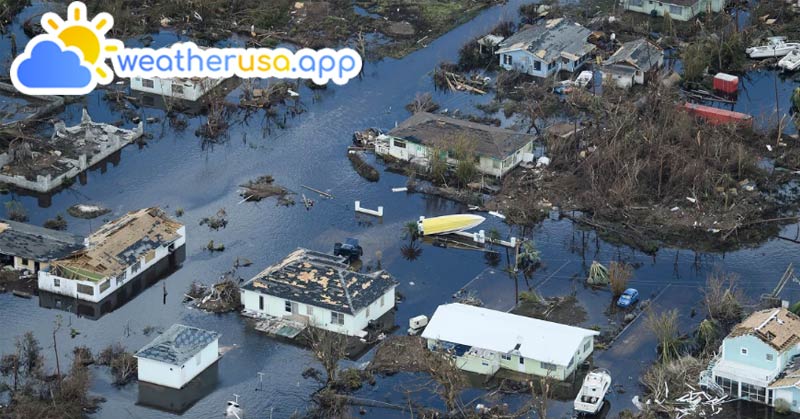
The 1913 Flood Ohios Most Significant Weather Event
Over a century ago in 1913, a massive flood wreaked havoc on Greater Cleveland, the entire state of Ohio, and 13 other states, marking it as the most widespread natural disaster in U.S. history at that time.
The Great Flood of 1913 was a major natural disaster that many are unfamiliar with, yet it had a profound impact on Greater Cleveland and the state of Ohio despite the flood prevention efforts in place. In January and February of 1913, early snowmelt caused the Cuyahoga, Licking, Scioto, and Muskingum Rivers to swell beyond their usual levels. Then, on March 23, heavy rains began and continued for four days, inundating Ohio with rainfall typically spread over two to three months. The city of Dayton was hit the hardest, with floodwaters reaching 20 feet. As the catastrophic flooding unfolded, there was little anyone could do. While some managed to evacuate, many were trapped and forced to endure the storm's wrath.
Climate and Average Weather Year Round in Ohio
During the storm, there was little local officials could do to protect homes, businesses, infrastructure, and, most importantly, lives. Many believed the dams, which had previously held back floodwaters along the Cuyahoga River, would be sufficient. However, the sheer volume of water overwhelmed these barriers. One dam in Akron failed, sending even more floodwaters into Greater Cleveland. In a desperate attempt to reduce flooding, officials dynamited several canal locks along the Ohio & Erie Canal, but the measures proved insufficient to prevent severe flooding in the area.

Officials urged evacuations to higher ground, yet some people were caught in the storm’s path. Workers at Cuyahoga Lumber were trapped while trying to save their stock, and train depot workers found themselves stranded, needing rescue from the second floor of the depot. Families also faced dire situations—one family, with four children suffering from measles, had to be rescued from their home after they were unable to evacuate.
Launching rescue boats during the flood was a perilous and exhausting task. Fire stations spearheaded the rescue efforts since they had the necessary equipment, including pulleys, ropes, and life preservers. The Flats area was particularly challenging for rescue operations due to debris-filled waters and powerful currents. Several boats capsized while attempting rescues, putting rescuers’ lives at risk. Remarkably, despite these dangers, no lives were lost during the rescue efforts.
It took days after the flood to fully grasp the extent of the devastation due to disruptions in telegraph and telephone services, as well as delays in communication, particularly in rural areas. Eventually, the widespread destruction became evident. In Ohio alone, at least 428 lives were lost, and 20,000 homes, along with countless businesses, were destroyed in the Great Flood. Public infrastructure also suffered greatly, with issues such as backed-up sewers, contaminated drinking water, inaccessible grocery stores, washed-out railroads, and destroyed bridges. It took weeks for the floodwaters to recede enough to begin the cleanup. Over half of the property damage caused by the Great Flood occurred in Ohio, amounting to an estimated $3 billion in today’s currency.
See more: Weather Forecast for Ohio
Weather Ohio for the next 7 days - Ohio
Weather Ohio for the next 15 days - Ohio
In the aftermath, difficult decisions had to be made in the days, weeks, and years that followed. One significant decision was the discontinuation of commercial use of the Ohio & Erie Canal. In the early 20th century, Ohio legislators had allocated funds for renovations in hopes of revitalizing the canal as a commercial corridor, much like it had been in the early to mid-19th century. Despite these repairs, industries in Greater Cleveland did not return to using the canal. The flood was the final blow, ending its use as a commercial waterway. However, thanks to later efforts in natural and historic preservation, the canal's Towpath Trail is now a place where people can enjoy recreational activities.
Another significant outcome of the Great Flood was the passage of the Vonderheide Act (Ohio Conservancy Law) in 1914. This legislation allowed for tax-funded flood control infrastructure improvements and the establishment of watershed districts. Although the law faced challenges that reached the Supreme Court, it was upheld, leading to the creation of the Miami Conservancy District in southern Ohio, the nation’s first major watershed district. Additionally, the state of Ohio undertook extensive repairs and built new levees and dams throughout the Ohio Valley to prevent future catastrophic flooding.
Despite the widespread devastation caused by the Great Flood across multiple states, it is not widely recognized as a major national disaster. This is partly because the flood is often remembered as a series of local events, such as the Great Dayton Flood or the Great Indianapolis Flood, rather than as part of a larger multistate disaster. These localized labels obscure the fact that all these floods occurred in March 1913 as part of a single, larger event. The Great Flood’s extensive damage led to significant changes in Ohio’s laws, flood prevention measures, and the end of a major commercial waterway, earning it the title of “Ohio’s greatest weather event.”
Weather 01852 - Lowell MA

82°
clear sky
Feels like 82°06:26/18:53
85°F
/80°F
38%
1024 hPa
7 mi
4.61 mph